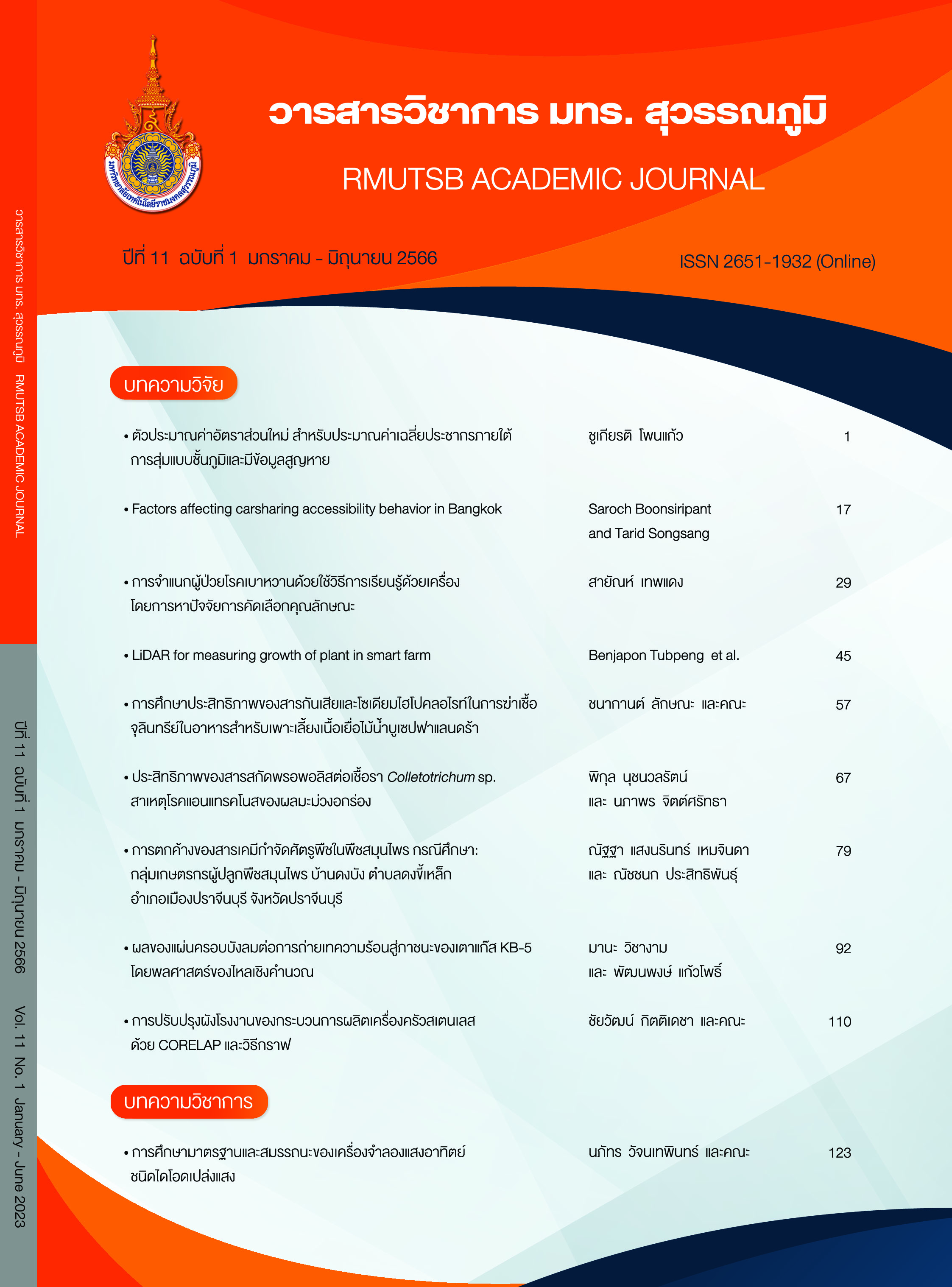Study of the effectiveness of preservatives and sodium hypochlorite for eradiation of microorganism in plant tissue culture medium for Bucephalandra aquatic plant
Main Article Content
Abstract
Plant propagation via tissue culture techniques requires a high investment due to the expensive equipment especially autoclave. Consequently, the objective of this study was to examine the effectiveness of preservative and sodium hypochlorite in sterilizing plant tissue culture media to lower the cost of culturing. Using 0.25 to 1.25% (v/v) preservative and final concentration of 0.10-0.50% (v/v) of sodium hypochlorite of commercial product were trialed. These media were not autoclaved and then used for culturing the sterile Buceparandra. It was found that in media containing preservative and sodium hypochlorite were able to increase the number of shoots at all concentrations and there was no statistical difference. The average number of shoots was 6.0±0.70-6.8±0.70 but there was a statistical difference from the autoclaved media which yielded 4.0±0.07-4.2±0.44 shoots. The media containing 0.25-0.75% of preservative were found to be contaminated with microorganisms while all concentrations of sodium hypochlorite-containing medium were not contaminated by microorganisms. Confirmation of the antiseptic efficiency of preservative and sodium hypochlorite in the preparation of Buceparandra tissue culture media was done by evaluating media without microbiological contamination on Luria-Bertani (LB) solid medium. It was discovered that preservative-treated tissue culture medium enhanced bacteria growth. While tissue culture medium prepared with sodium hypochlorite did not support the growth of germ-free cells, Therefore, it may be concluded that preservatives prevent the growth of bacteria, whereas sodium hypochlorite can eliminate microorganisms.
Article Details

This work is licensed under a Creative Commons Attribution-NonCommercial-NoDerivatives 4.0 International License.
Published manuscript are the rights of their original owners and RMUTSB Academic Journal. The manuscript content belongs to the authors' idea, it is not the opinion of the journal's committee and not the responsibility of Rajamangala University of Technology Suvarnabhumi
References
Brondani, G. E., Silva de Oliveira, L., Bergonci, T., Ebling Brondani, A., Macedo França, F. A., Lopes da Silva, A. L., & Natal Gonçalves, A. (2013). Chemical sterilization of culture medium: a low cost alternative to in vitro establishment of plants. Scientia Forestalis, 41(98), 257-264.
Cardoso, J. C., & Imthurn, A. C. P. (2018). Easy and efficient chemical sterilization of the culture medium for in vitro growth of gerbera using chlorine dioxide (ClO2). Ornamental Horticulture, 24(3), 218-224.
Chotikadachanarong, K. (2014). Influence of commercial bleach on sterilization of Persian Violet (Exacum affine Balf. F. ex Regel) tissue. Rajabhat Journal of Science, Humanities & Social Science, 14(2), 34-43. (in Thai)
Compton, M., & Koch, J. M. (2001). Influence of plant preservative mixture (PPM)TM on adventitious organogenesis in melon, petunia, and tobacco. In Vitro Cellular and Developmental Biology Plant, 37, 259-261.
Druart, P., & De Wulf, O. (1993). Activated charcoal catalyzes sucrose hydrolysis during autoclaving. Plant Cell Tissue Organ Culture, 32, 97-99.
Laohavisuti, N., Ruangdej, U., Seesanong, S., & Wangwibulkit, S. (2018). Effect of disinfectants and plant growth regulator in aquatic plant Bucephalandra sp. micropropagation. King Mongkut's Agricultural Journal, 35(2), 95-103. (in Thai)
Murashige, T., & Skoog, F. (1962). A revised medium for rapid growth and bio assays with tobacco tissue cultures. Physiology Planta, 15, 473-497.
Nuchnuanrat, P., & Jitsatta, N. (2021). Evaluation of fungicide carbendazim resistance in Colletotrichum gloeosporioidescausing anthracnose disease of mango cv. Aokrong in Chanthaburi province. RMUTSB Academic Journal, 9(2), 164-173. (in Thai)
Nugraha, M. F. I., Putra, T. A., Yunita, R., Enggarini, W., Erlinawati, I., Sahroni, D., Subamia, I. W., Ardi, I., & Cahyadi, A. (2022). The genetic diversity of genus Bucephalandra traded in the aquatic biota markets in Jakarta and the surrounding area based on RbCl markers. Acta Horticulturae, 1334, 389-396.
Redei, G. P. (1973). Effects of degradation products of fructose on the glycolytic pathway. Z. Pflanzenphysiologie, 70, 97-106.
Robert, M. S., Chu, M. C., Mann, M. L., Young, H., Sullivan, J., & Fermanian, T. (1986). Stability of tissue culture medium pH as a function of autoclaving, time, and cultured plant material. Plant Cell Reports, 5(4), 292-294.
Romadanova, N. V., Tolegen, A. B., Kushnarenko, S. V., Zholdybayeva, E. V., & Bettoni, J. C. (2022). Effect of plant preservative mixtureTM on endophytic bacteria eradication from in vitro-grown apple shoots. Plants, 11, 2624.
Sookruksawong, S. (2022). Sterilization and low-cost tissue culture techniques of Dioscorea bulbifera. Science, Technology, and Social Sciences Procedia, 2022(4), rspg014. (in Thai)
Suaib, S., Arief, N., Sadimantara, G. R., Suliartini, N. W. S., Rakian, T. C., & Ardhi. (2018). In vitro seeds germination and plantlets growth of hot pepper (Capsicum frutescens L.) on non-autoclaved murashige and skoog basal medium. Asian Journal Plant Science, 17(4), 173-181.
Tiwari, A. K., Tripathi, S., Lal, M., & Mishra, S. (2012). Screening of some chemical disinfectants for media sterilization during in vitro micropropagation of sugarcane. Sugar Technology, 14(4), 364-369.
Wang, X. J., & Hsiao, K. C. (1995). Sugar degradation during autoclaving: Effects of duration and solution volume on breakdown of glucose. Physiologia Plantarum, 94(3), 415-418.
Wann, S. R., Veazey, R. L., & Kaphammer, J. (1997). Activated charcoal does not catalyze sucrose hydrolysis in tissue culture media during autoclaving. Plant Cell, Tissue and Organ Culture, 50(3), 221-224.


